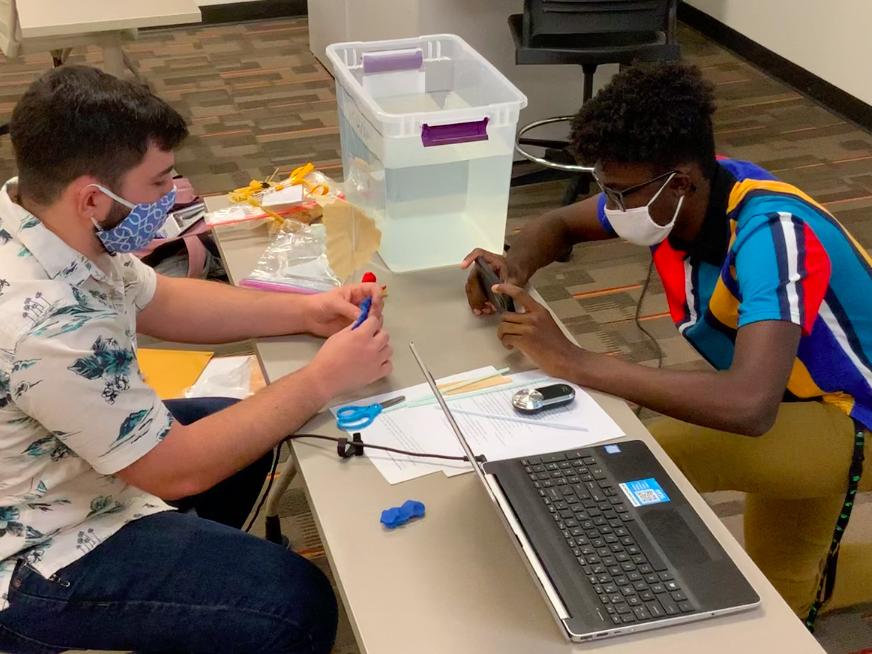Teaching tech -- Senior technology education major Gabrielle Bloise delivers a lesson during a STEM 4 Kids session in October. That program and Young Inventors allowed Oswego technology education students and schoolchildren to connect for hands-on lessons, the first time the popular program has been delivered online.
SUNY Oswego technology education students and schoolchildren had the opportunity to connect for hands-on lessons via the first-ever virtual STEM 4 Kids and Young Inventors programs.
The Oswego Technology Student Association and the department of technology launched STEM 4 Kids -- for kindergarten through third grade -- in 2012. When participants and parents asked for more opportunities for older children, the team added Young Inventors for fourth through sixth graders, all of which provides experience to future teachers in the technology curriculum’s “Teaching Methods” course.
But having to change the Kids Tech programs an online format required rethinking how to deliver effective lessons while retaining the engagement and real-time interest level of children.
Zachary Meal, a senior technology education major who was one of three lead teachers for Young Inventors Group D, said he learned a lot about the importance of flexibility teaching these virtual lessons.
“Adjusting all of our lessons, which had a focus on technical drawing and design, based on the pacing of students was key,” Meal said. “In a traditional classroom setting we would be able to gauge the student's progress more easily, but in an online setting that was much more difficult.”
Meal said he and his co-teachers adapted and learned about working together, while gaining insight into how many teachers function on a day-to-day basis.
“This definitely helped me to appreciate the work teachers have done and made me aware of the work that I have chosen for my future,” Meal said. “I have always enjoyed teaching new material to students, and this is the most authentic experience I can have with that while here at college. Knowing that I am going to be a teacher in the very near future, I have always wanted to get as much experience teaching as I possibly can.”
Appreciating imagination
Senior technology education major Anthony Alves, whose responsibilities for his STEM 4 Kids group ranged from lesson planning to demonstrating technology to coordinating the real-time chat, was impressed with the young learners.
“I learned to never underestimate a student's imagination along with their knowledge,” Alves said. “I found this to be the most interesting due to some of the students having such advanced and yet fun ideas to do the task given to them, some of which were better than our original ideas.”
And the challenges of devising and delivering virtual lessons ultimately will benefit their teaching ability, he added.
“I could see that not only myself but the rest of my group get more comfortable with the online platform,” Alves said. “I feel that I would be able to take this lesson with me to the next level. I believe that this was the most important lesson I learned during this opportunity.”
As a co-teacher/ facilitator, senior technology education major Gabrielle Bloise’s duties included teaching but also creating kits with hands-on materials the department mailed to students before the program, as well as creating lesson plans, booklets and PowerPoint presentations.
“With this unique teaching experience, I learned a lot,” Bloise said. “No group of up-and-coming teachers have ever taught the Kids Tech program the way that we did this semester.”
Bloise also appreciated that she and her classmates were trailblazers, creating new structures and lessons to adjust to changes forced by the pandemic.
“It was our responsibility to not only teach the students formal lessons in an online format but to set the precedent for how students in upcoming semesters will teach and produce content,” Bloise said. “I hope we will move forward to reopening our schools, but for now I am confident with the way we all ran the program with the new online format.”
Senior technology education major Carrington Vaughn appreciated how his roles changed from week to week, from teacher to co-teacher to chat recorder, as this gave him a variety of perspectives while making the overall lessons better.
“Creating a lesson plan and teaching to a small group of children is amazing, and I was grateful to be a part of it,” said Vaughn, who described it as “a great experience for a soon-to-be teacher.”
The experience confirmed for him, as well as other technology students, that they were on the right path.
“I love teaching, and coming up with activities for kids to enjoy,” Vaughn said. “I also learned that a lot goes into teaching besides the lessons and activities. The stuff that you have to write up and prepare for beforehand shows just how much teachers put into getting students to be at their best.”
Karin Dykeman and Mark Springston, Kids Tech program coordinators from the technology education faculty, have found these programs a beneficial teaching and learning experience that provides rich “hand-on, minds-on” STEM lessons and activities for elementary schoolchildren and their families from Oswego County. Going online for weekly October sessions also opened the program up for students across the state, from Buffalo to Westchester County.
Dykeman and Springston described it as “incredibly rewarding” for the technology students to see children’s faces light up when learning something new, and to hear the positive feedback from parents whose children receive engaging and meaningful STEM lessons and activities. With this edition under their belts, the department hopes to provide the next four-week sessions in April.
To see all the teachers and STEM activities from this semester, visit the fall 2020 Kids Tech website.

Virtual lessons -- Technology education students Chris Corr (left) and Carrington Vaughn teach a live video conference lesson on water transportation to their students from throughout New York state in the Young Inventors program.




